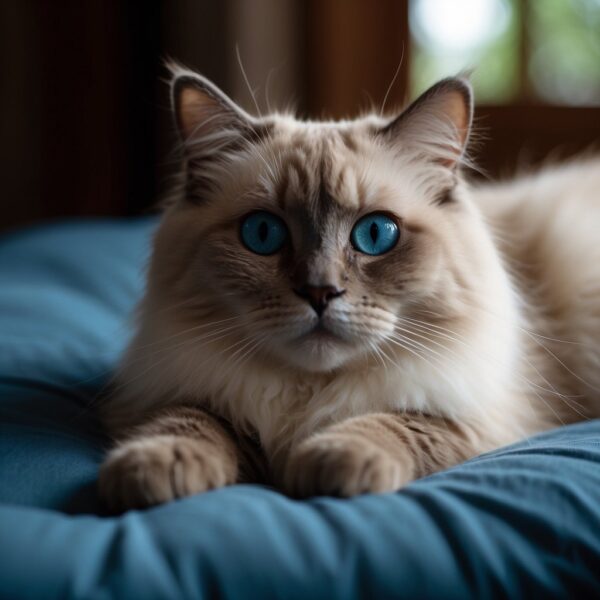
Ragdoll Cats
The Ragdoll cat is a captivating breed known for its striking blue eyes, silky coat, and sizable, sturdy physique. Originating in the 1960s in California, the Ragdoll has become celebrated for its docile and affectionate nature. They also display a peculiar tendency to go limp when picked up, which is how the breed got their unique name. Ragdolls cats flourish in the company of their human families, following people around and seeking attention, making them an excellent companion.
With their semi-long fur and color point coat, maintenance of a Ragdoll cat involves regular grooming to prevent matting and to manage shedding. Though they’re large cats, with males weighing up to 20 pounds and females slightly less, they adapt well to various environments, including indoor living spaces. Future guardians should be aware of potential genetic health issues such as hypertrophic cardiomyopathy and should prioritize regular veterinary check-ups to ensure a long, healthy life for their Ragdoll companion.
Key Takeaways
- Ragdoll cats possess distinctive blue eyes and a friendly demeanor.
- They require routine grooming and are known for their large size.
- Regular health monitoring is crucial to address potential genetic conditions.
Ragdoll Cat Breed Origins and History
The Ragdoll cat breed emerged in the 1960s in California, thanks to the efforts of a breeder named Ann Baker. This breed is distinguished for their placid temperament and affectionate nature.
Ann Baker and the Founding of the Ragdoll Breed
Ann Baker, a breeder from Riverside, California, is credited with developing the Ragdoll breed. In the 1960s, she established the International Ragdoll Cat Association (IRCA) to regulate and oversee the breeding of Ragdoll cats. Baker’s breeding program was unconventional for its time, as it emphasized personality traits such as a calm demeanor and a tendency of the cats to relax completely when held, which is how the breed got its name.
Josephine and the Genetic Basis of Ragdolls
The origin of the breed traces back to a domestic longhaired white cat named Josephine. After a car accident, it is claimed that subsequent litters born from Josephine displayed the unique Ragdoll traits—the gentle, docile nature and a propensity to go limp when picked up. These characteristics set the foundation for the Ragdoll breed. Genetic factors from Josephine contributed to the distinct qualities for which the Ragdolls are known today.
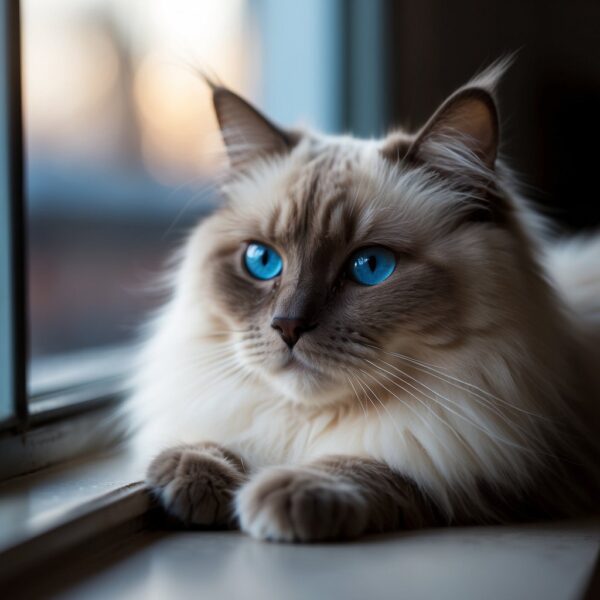
Breed Characteristics
The Ragdoll cat breed is renowned for its striking appearance, large physical stature, and unique coat patterns. These gentle giants have an array of distinct features that make them easily recognizable and much adored by enthusiasts worldwide.
Defining Features
The face of a Ragdoll cat exhibits a sweet expression, highlighted by their characteristic blue eyes. Typically, a Ragdoll’s ears have a rounded appearance, with semi-long coats that feel silky to the touch. This breed is famously known for going limp when picked up, much like the fabric doll their name references.
Color Patterns and Coat Types
Coat color and patterns in Ragdolls can be quite varied, but they all share the pointed pattern—with darker coloration on the face, ears, paws, legs, and tail.
- Colors: Seal, chocolate, lilac, and more
- Patterns:
- Bicolor: Darker points with a white chest and stomach
- Mitted: Similar to bicolor but with white “mittens” on the front paws and boots on the back legs
- Colorpoint: No white. Points are the only areas with darker colors
- Lynx: A variant of the traditional patterns with tabby striping
Physical Size and Body Shape
Ragdolls are large and muscular cats with a sturdy body shape that adds to their impressive size. Typically, males range from 15-20 pounds and females from 10-15 pounds, making them one of the larger domesticated cat breeds. Despite their size, they have gentle, soft movements and a calm, affable demeanor.
- Body: Powerful and robust, yet with a soft, plush feel
- Size: Large, among the biggest of domesticated cats
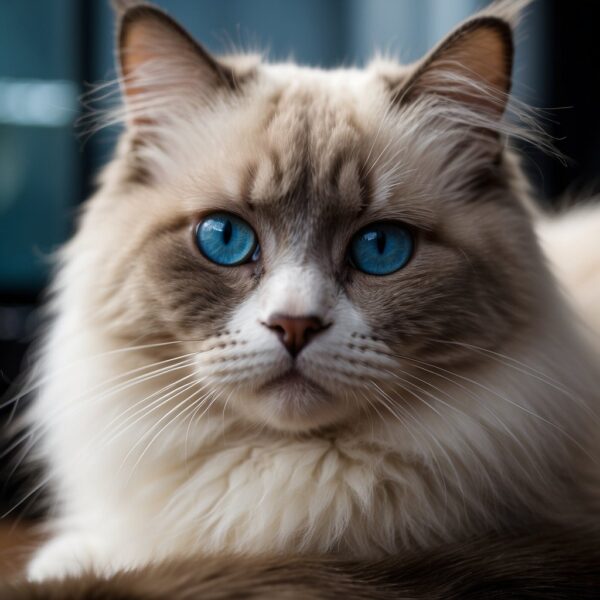
Behavior and Temperament
Ragdoll cats are distinguished by their gentle, affectionate nature and amiable temperament. These cats are often sought after for their easygoing personality and compatibility with family environments.
Personality Traits
Ragdoll cats exhibit a playful and patient demeanor, often displaying a kitten-like zest for life well into adulthood. While naturally quiet and laid-back, they possess a notable intelligence that makes them responsive and easy to train for tricks or habits like coming when called. These felines tend to be particularly affectionate, seeking out the company of their guardians and enjoying cuddle time. Their docile nature should not be misunderstood as a lack of awareness — Ragdolls usually adapt well to their surroundings and carry a serene confidence in their daily interactions.
Social Behavior and Compatibility with Families
When it comes to social behavior, Ragdolls are regarded as friendly and social companions. These traits make them excellent pets for families, including those with children. They are typically trustful and can often build strong bonds with all family members, displaying deep affection without favoritism. This breed is known for its ability to get along with other pets due to its non-aggressive demeanor. This inclusiveness and acceptance make them a harmonious addition to diverse and active households. Their patient nature also means they handle the dynamic energy of children with grace and composure.
Health and Care
Ragdoll cats generally enjoy a healthy lifespan, which can extend up to 17 years. However, attentive care focusing on nutrition, grooming, and exercise is crucial to mitigate common health issues and maintain their wellbeing.
General Health Concerns
Ragdoll cats may face several health challenges, such as hypertrophic cardiomyopathy (HCM), which is a common heart condition in this breed. Cat parents should ensure regular veterinary check-ups to monitor for this condition. Obesity is another concern for Ragdolls due to their large size and often sedentary lifestyle; a balanced diet and adequate exercise are vital to managing their weight. It’s essential to keep their diet nutritionally sound, and caloric intake controlled to prevent excessive weight gain, which can lead to further health complications.
| Health Concern | Preventive Measures |
|---|---|
| HCM | Regular veterinary check-ups |
| Obesity | Balanced diet, exercise |
Grooming Needs
The Ragdoll’s coat is semi-long, silky, and prone to matting without proper care. Regular grooming includes brushing their plush fur at least twice a week to minimize shedding and prevent tangles. Their fur is longer around the neck, which may require additional attention. Cleaning their coat also aids in reducing hairballs and maintaining general cleanliness. Brushing also provides the necessary attention they crave, supporting their emotional health.
| Grooming Task | Frequency |
|---|---|
| Brushing | Twice a week |
| Cleaning | As needed |
Breeding and Genetics
Ragdoll Cat Breeding Practices
In the world of cat breeding, Ragdoll cats are renowned for their distinctive colors and patterns, which are the result of careful selective breeding. Breeders focus on maintaining the genetic purity of the Ragdoll breed while ensuring healthy lineages. Responsible breeding practices include genetic testing to identify and prevent the spread of heritable diseases. Ragdolls may have pointed, mitted, or bi-color patterns, and most have striking blue eyes as a breed standard.
Inherited Traits and Genetic Diversity
The genetics of Ragdoll cats contribute to their unique coats and sturdy physique. The Ragdoll breed exhibits a variety of coat colors, including seal, blue, chocolate, lilac, and more. Genetic diversity is important for maintaining the health of the Ragdoll cat population. Breeders strive to expand the gene pool by introducing unrelated cats that still meet breed standards in order to avoid inbreeding depression, which can lead to genetic disorders. Patterns like colorpoint, mitted, and bi-color are inherited traits that also receive careful attention during breeding.
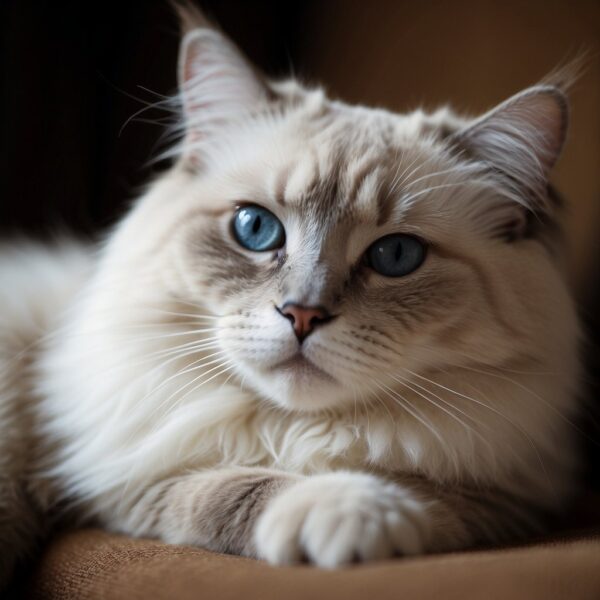
Adoption and Guardianship
When considering the addition of a Ragdoll cat to your family, the paths to adoption and understanding the responsibilities of guardianship are critical. Prospective parents should evaluate options between adopting from a shelter and purchasing from a breeder, with attention to the unique aspects of the Ragdoll breed.
Choosing a Ragdoll Kitten
When selecting a Ragdoll kitten, it’s important to look for signs of good health and social temperament. Ragdoll kittens should appear alert, active, and free from any signs of illness. A reputable breeder who is registered with organizations such as The International Cat Association (TICA) or the Cat Fanciers’ Association (CFA) is more likely to offer kittens with documented lineage and health clearances.
- Health: Ensure that the kitten has been vet-checked, vaccinated, and dewormed according to age-related protocols.
- Socialization: Ragdolls are known for their friendly nature. Choose a kitten that displays a good balance between playfulness and affection.
Cost is a considerable factor in choosing a Ragdoll kitten. Purchasing from a breeder can be notably more expensive, with prices ranging from $800 to $3,500. Conversely, adoption fees from shelters or rescue groups tend to be much lower, typically between $75 and $100, making it a cost-effective alternative.
When opting for adoption, potential parents may find adult Ragdoll cats or even Ragdoll mixes which offer the breed’s prized characteristics at reduced costs. Rescue organizations like Merlin’s Hope: Ragdoll Rescue focus on rehabilitating and rehoming Ragdoll cats, providing an option to adopt a furry companion while also contributing to animal welfare.
Whether choosing to adopt from a shelter or to work with a breeder, it’s essential that guardians prepare for a long-term commitment. Ragdolls are known for their loyalty and affectionate nature, traits which contribute to a rewarding, long-lasting companionship with their human family.
Environmental Adaptation
Ragdoll cats are well-known for their adaptability to indoor living environments and their moderate exercise needs. They thrive in home settings where their social and physical requirements are met.
Indoor Living and Exercise Requirements
Ragdoll cats excel as indoor pets due to their calm and affectionate nature. They possess a placid temperament that makes them ideal for apartment living and homes without outdoor access. These cats require a safe, secure, and enriching environment to maintain their mental and physical health.
- Indoor Adaptation: They adapt well to indoor life, often seeking out cozy spots for napping and observing household activities. It is crucial to provide them with vertical spaces, like cat trees, and cozy resting areas to satisfy their instinctual needs to climb and survey their territory.
- Exercise: While they display a more relaxed demeanor, Ragdolls still need regular exercise to stay healthy. Interactive play with toys and engaging activities can stimulate their minds and bodies. Make sure to dedicate playtime each day to keep them active.
- Attention and Companionship: These cats crave attention and companionship, making them well-suited for families and individuals alike. They tend to follow their parents around and enjoy being involved in daily activities.
- Scratching Posts: Providing multiple scratching posts in various locations is important, as it allows them to stretch their muscles and maintain claw health.
- Litter Box: A clean litter box is essential for indoor living, and Ragdolls, like all cats, should be trained early on to use it.
In homes with other pets, Ragdolls generally get along well with their companions. Their friendly disposition often leads to harmonious relationships with other cats and even dogs. Always ensure that any introduction to new pets is gradual and supervised to avoid stress for all animals involved.
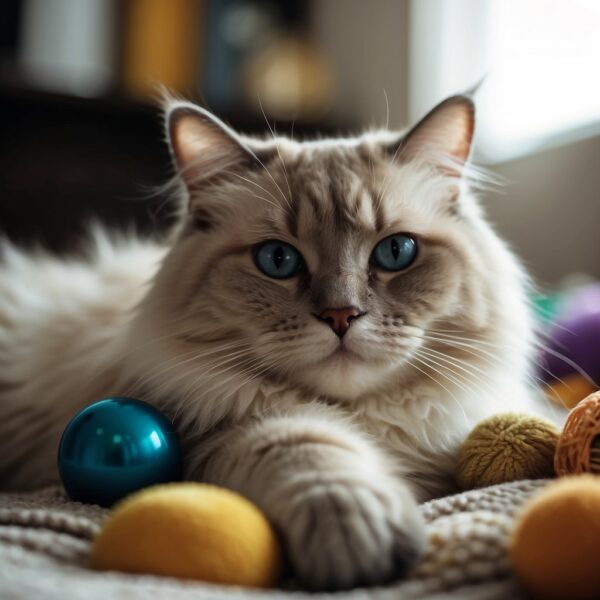
Frequently Asked Questions
In this section, we address some of the most common questions regarding the Ragdoll cat breed to provide clarity and understanding for potential parent and enthusiasts.
What is the average price range for a Ragdoll kitten?
The average cost of a Ragdoll kitten typically ranges from a few hundred dollars to upwards of two thousand, depending on pedigree, breeder reputation, and coat color.
What are the distinctive personality traits of Ragdoll cats?
Ragdoll cats are known for their affectionate and docile temperament. They are often described as friendly, intelligent, and playful, with a tendency to go limp when picked up—hence their name.
How do Ragdoll cats compare in size to average domestic cats?
Ragdoll cats are among the largest domesticated cat breeds. An adult Ragdoll can weigh between 10 to 20 pounds, which is noticeably more than the average domestic cat.
What are some potential drawbacks of Living with a Ragdoll cat?
Some drawbacks of living with a Ragdoll cat can include their need for regular grooming due to their long fur, as well as potential health issues common to the breed such as hypertrophic cardiomyopathy.
What is the history behind the Ragdoll cat breed’s origin?
The Ragdoll breed originated in California during the 1960s. Breeder Ann Baker played a significant role in developing the breed, starting with a cat named Josephine, who passed on her gentle disposition to her offspring.
Are Ragdoll cats generally more affectionate than other breeds?
Ragdoll cats are often regarded as being particularly affectionate compared to other breeds. They commonly seek out human companionship and may follow their guardians around the home.